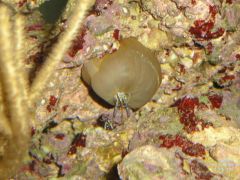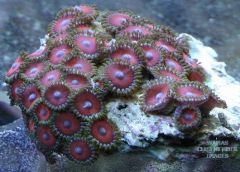-
Posts
654 -
Joined
-
Last visited
Content Type
Profiles
Forums
Gallery
Events
Store
Everything posted by jaddc
-
That's a tough question to answer. But if that is what is happening, you may be able to counter that by increasing the GAC and perhaps swapping it out more frequently. You feed the corals, right?
-
Doh! Good catch, Tom! I didn't mean to imply that it cannot be aerosolized. I was trying to say that we know how to prevent exposure to the toxins and pathogens in the tank. In the lab, we have special containment hoods that suck the aerosolized toxins out of the local environment. But yes -- at home, you'll need a respirator or great ventilation (like outside your home). I wouldn't boil or "cook" anything inside a building, just in case.
-
That Benadryl did not work is a big clue. So its not an allergy (unless Benadryl does not normally work for you guys). While I'm not convinced its palytoxin, you could have been hit with a bacterial toxin or had an acute immune response to a pathogen... like Vibrio. You mentioned lizards? They can harbor a lot of bad bugs. I completely agree with Jan -- you guys have a sensitivity to something. Most of us can dive into our tanks without any trouble. Others have been sent to the ER. Fortunately, toxins aren't a mysterious vapor and we know how to be safe. Wear gloves all the time. Wear eye protection all the time. Always make sure you have adequate ventilation when working in the basement. Immediately wash your hands and face if you get splashed with copious amount of water. You may want to consider wearing old clothing that you can immediately take off and wash when you work on the tank. These are the precautions I and my colleagues take to make sure we don't poison ourselves in our laboratory work. Again, if anyone is struggling for breath or the heart is beating erratically, call 911. Don't drive. Call 911. Stay safe.
-
Seriously -- if it was Palytoxin, I have some friends who would be *very* interested in your case study. It would be a rare case study and would advance our scientific knowledge. Often times there is little difference between an allergic (or pathogen) immune response (e.g. to mold, bacteria) and a neurotoxin. It does make good sense to take an antihistamine as soon as symptoms arise when you work on the tank. If the antihistamine does not work, or your symptoms get worse, then there is probably a good chance that you were hit with a neurotoxin. There is no effective treatment or cure for any of the marine toxins. All medical staff can do is administer life support until your body naturally excretes the toxins. Practically, what that means is that you would simply wait in the ER waiting room until you felt better or collapsed. What do people think about the idea of aerosolized DOC's coming from the protein skimmer or other areas of agitation? I think those would be prime suspects for allergies.
-
Hey everyone. I'm not a medical doctor but I am a scientist that works with various toxins. Palytoxins are very dangerous. That said, I am hesitant to blame palytoxins for your symptoms. Palytoxins are released when the zoanthids are stressed. Usually this is by fragging or cooking -- the tissue of the coral needs to be damaged. It is not probable that you would be poisoned by simply working with the tank in a routine fashion. Palytoxin impairs the nervous system. So you'd have GI symptoms if you inject it (the usual like nausea, diarrhea). You'd also have muscle spasms, slower heart rate, lethargy if it gets to your blood. If you breath it in, you'd feel like your lungs were tightening. If it hits your eyes, you will have conjunctivitis. So what happened to you guys? My guess is that you are having an allergic response to something in that environment. You'd have to be systematic to find out what it is. For example, if you spend 2 hours in the basement, but don't work on the tank, will you have the same reaction? What if you work on the tank but don't put your hands in the water? etc. etc. There is no treatment for palytoxin. Medical attention is required when poisoning is so severe that the patient is in respiratory distress. In that case, the trauma team will intubate and administer respiratory support until your body metabolizes and ejects the toxin. As for safety -- assume all Zoanthid/Paly polyps contain palytoxin. When I frag my polyps I wear latex gloves and eye protection. But also corals use a lot of biochemical warfare. You may sensitive to something growing in your tank. But that would be tough to figure out. In the meantime, if Benadryl lessens your symptoms, then it is not palytoxin poisoning. Benadryl will not do anything for toxins/poisons -- different medical phenomena. This is just my opinion.
-
+1 on pods if they are small. My smallest mantis was 1" long.
-
Where did you get the rock? If you have only 20 lbs of rock I would pull out all the rock and pour seltzer over the rock over a bucket of salt water. I had 50 lbs and I caught 2 shrimps in like 20 minutes. Give them away. Someone will want them.
-
Neat! Considering what they face in the ocean I think their odds are better in your tank...
-
Christmas in September!! Fun! Did you pull out more rock or did you decide to leave it all in there?
-
Nice! Love dr. Macs. Solid business. BTW the gbta and zoa frags i got from you are growing fast in my tank. Your set up is awesome! Keep up the good work.
-
Since your tank does not have much in it, imho my recommendation is to starve the algae -- kill the lights in the DT but light up the chaeto 24/7. But you have to be aggressive with the water changes and weeding to remove the nitrate. While you have algae problems, I'd suggest changing the GFO media at least once a week. Good luck!
-
Yes, you do need some algae. IMHO the film on the glass and coralline algae is good enough. people also put in chaeto to control nutrients. But what does one do? One prunes the chaeto for nutrient export. Same idea. Pruning is cheaper than buying organisms. And when the gha problem goes away then what are those organisms going to eat? All I can say is that I solved my red hair algae and green hair algae by pulling the stuff of rocks. It was simple and cheap. Of course in the process I made changes to my feeding amount and added gfo and increased water changes.
-
There are many organisms that eat GHA. But consider this -- the tank is a closed system and matter cannot be created nor destroyed. If something eats the GHA, then sure the algae is gone, but the nitrogen and phosphorous is still in the tank. Once the nudibranch poops, the nitrogen and phosphorous is released back into the tank. The aerobic bacteria breaks down the nudibranch poop and converts the nitrogen into NH3 then NO2 and then back to NO3 and phosphorous. Now the GHA that has not been eaten has the food to grow all over again and the problem continues. When we weed our gardens, if we don't eliminate the roots...the weeks grow back.
-
I had some of that. I just pulled it off the rock. It was a pain but after aggressively weeding the rocks for a week or two it has not returned. If something eats algae, then the nutrients are returned into the tank via waste products. So the algae continues to grow even though something is eating it because algae are good scavengers.
-
The only way to eliminate any algae problems is to remove the nutrients from the water. You have to harvest the algae. If a CUC eats the algae then the nutrients are still in the system, since the organism eliminates waste, and since algae is very efficient at scavenging for nutrients, it pulls it in very fast. I had gha and it was a pain but I pulled out every bit I could get my hands on. This physically pulls the nitrates and phosphates out of the system and the problem solves itself. Now my tank is algae free and water changes and gfo keeps the algae at bay. Hth
-
Not sure what nem you have, but my fatty mandarin plays well and steers clear of my huge condy in my 28g.
-
FWIW, I have a JBJ 28g and I run a media reactor. It's pretty tight in the back sump area with an extra pump, but I have GFO and GAC in the reactor. So I basically just have a filter sponge in the overflow and that's it. Because your tank is small, you don't need a large pump. I dose vodka (the live sponges and protein skimmer remove the excess bacteria). The remaining phosphate gets soaked up by the GFO.
-

Is there a Sea star that won't eat my maxima Clam?
jaddc replied to sen5241b's topic in General Discussion
If you want a star, then do what I do. I feed my star a small piece of table shrimp (soaked in a vitamin mix) twice a week. My star does not eat anything it should not. -
From the album: My 28g tank
I believe that these are Eagle Eye Zoas. -

renew biopellets or turn to dosing microbacter?
jaddc replied to davidm's topic in General Discussion
If the biopellets work for you, then I'd stick with them and just restock the reactor. -
Lots of ideas and inspiration for my JBJ 28g! Very nice tank -- thank you for sharing.
-
I'm not sure about what Cheato needs to thrive since I don't use it. I can say that if you offer your pods a rubble pile in the sump or DT, they will naturally migrate there for protection. So if the flow is high, then they will find protection in the rubble. Once they colonize the rubble, then they will begin reproduce there and the eggs will be protected and so the population will grow and explode in about a month or two. I use a pile of snail shells in the back corner of my DT to keep my pods (and target mandarin) happy. It was like "Field of Dreams" -- if you build it, they will come.
-
I should also mention that you should expect to have high phosphate readings for a while. Then at some point, it will drop dramatically.




